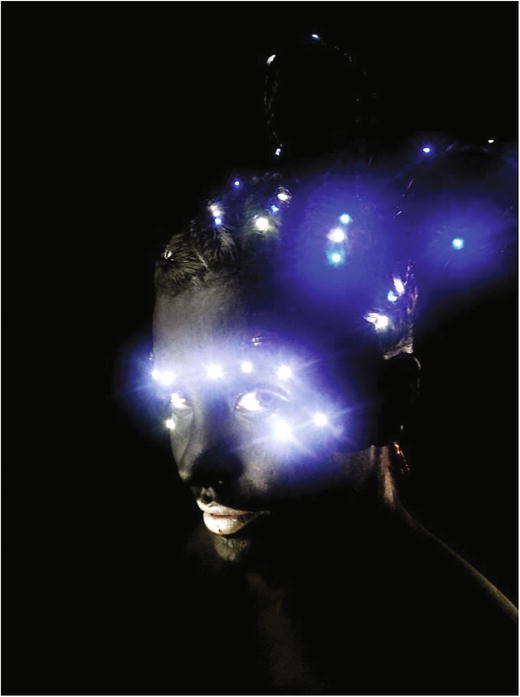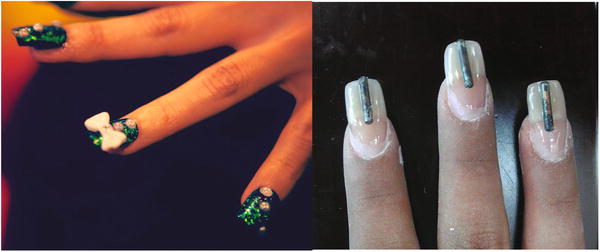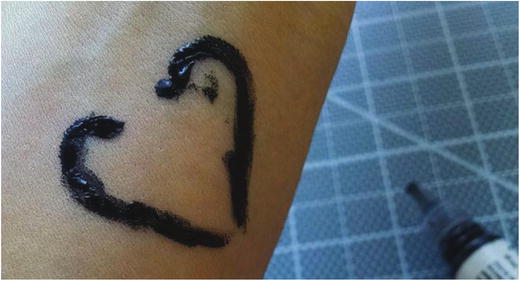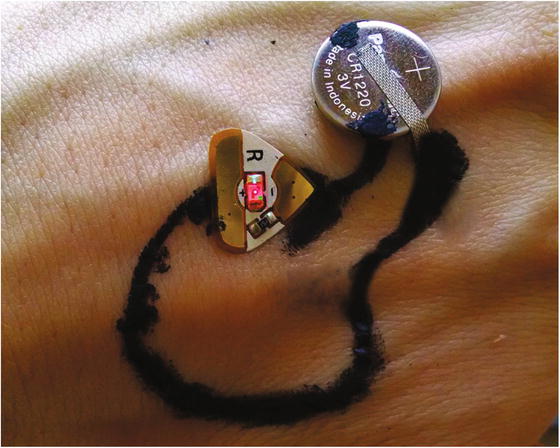Beauty and technology are two words that are not often used together. Technology might be described as being beautiful, in the sense that it is simple and well designed, but can beauty be technological? The term beauty technology, coined by computer scientist Katia Vega, is an emerging field of wearables that refers to electronic devices that are attached to the surface of the body and enable the wearer to interact with the digital world. These interactions are not disruptive to the wearer’s everyday routine; on the contrary, they are designed to integrate into natural tendencies and actions such as blinking or waving.
Beauty technology has been applied to different fields such as fashion , makeup , and medicine . Chapter 2 mentioned X-ray technology as a method of getting under a person’s skin; beauty tech is a method for sticking to the skin. Both medical and design researchers are developing sensors that can be applied directly to a person’s skin. This can be extremely beneficial for taking accurate measurements of body parameters or tracking movement. This chapter discusses various projects that use beauty technology to create more advanced or intimate wearable experiences.
The Beauty Technologist
Katia Vega is a beauty technologist working at the intersection of invisible computing and fashion. Vega’s work is inspired by magic and empowering human capabilities with technology. During her doctoral studies, she worked as a research assistant in the Wearables Lab at Hong Kong Baptist University, where she noticed that a lot of women wore fake eyelashes, nail stickers, and makeup on a daily basis. She thought, “Why not add a little technology to these elements?” This question led to her invention of beauty technology. Vega works to create beauty enhancements that can give the wearer robotic powers but are completely imperceptible from the outside. Furthermore, they do not fit any traditional robot aesthetic. She wants her “magical” electronic devices to be hidden on the body, emphasizing the feeling that they are giving the wearer secret powers. She is currently a postdoctoral associate at the MIT Media Lab, where she researches beauty technology, wearable computers, and human-computer interaction (HCI) . The following sections highlight some of her inventions; you can follow her work online at http://katiavega.com .
Hairware
Vega’s latest project, called Hairware , uses metalized hair extensions as a capacitive touch interface. Hairware explores the conscious use of unconscious auto-contact behaviors. Touching or twirling a strand of hair is a common comfort behavior that women unconsciously perform. Hairware takes this behavior to a new level by triggering actions when the wearer touches the metalized capacitive touch-sensing hair extensions.
Artificial hair is chemically metalized, which makes it conductive while keeping its natural color. Layers of nonconductive hair are attached around the conductive hair to protect it from the wearer’s skin. Depending on which part of the extension the wearer touches (top, middle, or bottom), the sensor sends out different output values, which are input into a microcontroller to control digital devices. For example, when the wearer touches certain points on her hair, a signal is sent to her phone to send out her geolocation.
Hairware allows the wearer to use her auto-contact behaviors as a secret interface. This raises an interesting debate about the advantages and disadvantage of disguising technology on our bodies. Is it fair to hide these interactions in social situations, or will it become so common that it is expected? These questions are discussed further in Chapter 16.
More than Makeup
Conductive ink was introduced in Chapter 6 as a recommended material for your wearable toolbox. Conductive ink allows you to draw circuits on fabric, paper, and even skin! Katia Vega and her collaborators began experimenting with conductive makeup in 2010 by creating eyeliner from conductive ink. This technique proved to be problematic because although the ink is not hazardous to the body, it is not approved for use on skin. Additionally, the ink is water-soluble, and the humidity from the wearer’s eyes and skin can cause issues. The group decided to take another approach to applying conductive makeup to the skin: stickers. They created makeup stickers by covering thin conductive tape with makeup ink. For example, a thin, black, conductive makeup sticker can be applied as eyeliner. The stickers do not cause irritation and are easily removable.
Another makeup product the team electrified is fake eyelashes . Instead of applying liquid conductive mascara, fake eyelashes are chemically metalized, which allows them to keep their black color. The metalizing process involves two parts: first the eyelashes are activated with hydrogen and tin chloride, and silver nitrate is added to prepare the eyelashes to catalyze the electron transfer. Second is an electrolysis phase, during which a layer of nickel is deposited on the eyelashes to plate them. The plating contains copper, which makes the eyelashes electrically conductive; and black nickel, which gives the natural black color of the eyelashes (see Figure 12-1).

Figure 12-1. Fake eyelashes being metalized at EQA lab (left) and tested (right) (photos courtesy of Katia Vega)
Following is a list of Vega’s projects that use conductive makeup technology:
Blinkifier: A wearable computer that amplifies the action of blinking without using intrusive devices on the face. As the muscles around the eye contract, a series of LED lights, embedded in a wearable headpiece, display different patterns depending on the blinking gesture. The project uses conductive eyelashes to capture the blinking motion. Every time the wearer blinks, the metalized lashes come into contact and close the circuit, thus acting as a switch input. The eyelashes on the top eyelid act as one side of the switch, and the bottom lashes are the other side. This input signal is transmitted through conductive eyeliner stickers to an Arduino in the headpiece that sends an output signal to trigger the LEDs.
Kinisi: An FX e-makeup application that was designed to turn skin into an interface that is controlled by a smile, a wink, or the raising of an eyebrow. It is similar to Blinkifier in that conductive makeup is used to control light patterns of LEDs. Instead of a wearable headpiece, the LEDs are applied directly to the skin and hair of the model and covered with FX materials, as shown in Figure 12-2. In addition to the metallic lashes and conductive eye makeup, conductive lipstick was developed. Vega and her team collaborated with Larca Meicap, a special effects makeup artist, who added her FX materials to the Beauty Technology sensors to precisely apply the sensors on specific muscles.

Figure 12-2. Kinisi model with LEDs lit up around her eyes and in her hair (courtesy of Katia Vega)
Superhero: An e-makeup circuit that triggers output or levitates an object when the user blinks. The circuit is made from conductive makeup, black metalized fake eyelashes, and a radio transmitter. Like Blinkifier, the metalized eyelashes are used as a switch input to the transmitter. Each time the user blinks, a signal is sent to the radio receiver, hidden in a handbag nearby. The receiver is programmed to output animated images—“POW,” “BAM,” and “ZAP”—that are displayed on a screen each time it receives a signal. In another version of this circuit, blinking is used as an input to trigger infrared commands that are then decoded for the remote controller of a toy helicopter. By blinking her eyes, Vega is able to launch the helicopter into flight!
Beauty Tech Nails
Another technology developed by Vega is her Beauty Tech Nails. These are fake fingernails that are embedded with RFID tags, small magnets, or conductive nail polish. These elements enable the wearer to interact with other electronic wearable devices or objects in their environment. The RFID glass capsules embedded in the nails are used with an RFID reader that can identify each individual tag and trigger an application based on the input of one nail or the combination of a sequence of nails in a specific pattern. The magnets can amplify the wearers’ sensing abilities by allowing them to sense magnetic fields and objects with magnetic switches, such as smartphones and tablets. The conductive nail polish can be used to complete a circuit when it comes in contact with other conductive materials.
Following is a list of projects that use Beauty Tech Nails :
Gimmickiano: In a live performance, DJ Maribel Tafur wore RFID nails to “play” the piano. The nails are shown in Figure 12-3. As she moved around the auditorium and waved her fingers over a wearable belt embedded with an RFID reader, the belt sent the notes to a computer through a radio module. Depending on the input pattern received, different notes were played by a computer interface.

Figure 12-3. Decorated RFID nails from Gimmickiano (left); exposed RFID tags on nails (right) (courtesy of Katia Vega)
Abrete Sesamo: This project was inspired by the ancient Ali Baba tale, in which a cave that holds a treasure can be opened with the words “iftah ya simsim” (“open sesame” in English). Vega and her team created a version of this lock, using a combination of finger movements instead of a secret phrase to open the door. RFID glass capsule tags are inserted into gel nails and hidden with nail polish and decorative crystals. An RFID reader receives the input combination from the nails and transmits it to a microprocessor that opens the door when the correct code is entered .
Living Makeup
Makeup and electronics are not only being applied to the face with new conductive materials; they are also being projected onto faces as dynamic masks. Omote is a project led by Japanese producer Nobumichi Asai, who is known for his work in projection mapping, to create what is being referred to as living makeup. Omote translates as face or mask in Japanese. Using advanced face tracking and projection mapping, the team has invented a system to project images onto a user’s face in real time that can simulate anything from makeup to cascading water. Asai states that he was inspired by the medium of the human face, which he considers to be the most “powerful but delicate medium for art.”
Face tracking is widely used in security and marketing applications, but Asai wanted to use this technology in a different way: to express beauty and the art of makeup, specifically Japanese beauty. He was inspired by Japanese aesthetics and Japanimation, a term referring to the Japanese anime subculture. Updating the image with every slight movement of the user’s face required a much more precise algorithm than other face-tracking systems. Coordinating the timing of the computer graphic renderings to match the face is impressive. He hopes to continue to develop new technologies that express beauty with new media. A model with an Omote mask that seamlessly changes from one projected image to another is shown in Figure 12-4.

Figure 12-4. A model wearing an Omote mask that changes from one projected image to another (© nobumichiasai.com )
Dermatology and Technology
Wearable technologies are being researched and developed for more than makeup and masks; researchers have also been exploring the potential of wearable technologies for dermatology. The applications of these technologies range from anti-aging to dermo-therapy . Studies have shown that although medical tracking devices like the Fitbit (discussed in Chapter 11) are very promising, the majority of users do not use them for more than 6 months. Therefore, researchers are trying to redesign these devices to be smaller and less invasive. Doctors and medical experts are looking forward to these advancements and believe that with the help of these sensors, they can lower the rate of ER visits and keep patients healthier. The following two companies innovating in this field, sometimes referred to as the Internet of healthy things:
MC10: The MC10 BioStamp is a temporary tattoo, the size of two postage stamps and thinner than a Band-Aid, that acts as electronic skin. A picture of the stamp on human skin is shown in Figure 12-5. Using common sensors like accelerometers and gyroscopes, the BioStamp can monitor temperature, movement, heart rate, brain waves, and more. It then transmit wirelessly to a computer program that analyzes the data. The stamp is waterproof and powered by a thin film battery that can last more than 24 hours and is charged wirelessly. One concern is that because it is a skin patch, wearing it for too long could cause dermatitis.

Figure 12-5. The BioStamp, which has five built-in sensors, wireless communication, and more (© MC10 Inc.)
Feeligreen: Feeligreen is a French company that has developed a line of makeup and skin patches that address aging and other skin-related conditions. The dermoPatch is an under-eye adhesive sticker that applies a microcurrent technology across the skin. The microcurrent technology increases the pharmoco-kinetics of ionized drugs and transdermic diffusion of active molecules, thus improving their efficiency in the treatment of certain types of local pathologies. Feeligreen says this could be applied to a large range of drugs that treat neuropathic chronic pain, skin cancer, bedsores, arthritic pain, and diabetes; provide needleless vaccines; and can be used for cosmetic applications such as anti-aging, depigmentation, and cellulitis.
Another interesting technology that plays into this field is transient electronics. These are tiny, biocompatible electronics that dissolve after a set amount of time. They are encased in layers of silk protein extracted from silkworm cocoons and are fully biodegradable. Researchers have discovered how to adjust the properties of the silk such that it dissolves at a specific time. They believe that this technology will be widely used in medical implants, consumer electronics, and environmental monitors. Although this technology is still being tested and developed, it is extremely promising for wearable applications.
Conductive Tattoos
Along with medical and beauty products, conductive tattoos are popular among artists, designers, and hackers. Some of these tattoos use conductive inks, such as Bare Conductive. Although these inks are safe to use on the skin for short periods, they are not recommended for long periods, as Vega discovered in her research. Amrita Kulkarni, an Indian designer, has been experimenting with conductive ink in her henna designs. Using small LED lights and coin-cell batteries, she draws intricate patterns on her skin and embeds simple light circuits throughout. Chaotic Moon, an Austin-based design firm, is using this ink to prototype more complex skin circuits for DIY health monitoring and embedding banking information onto the skin to replace credit cards. The company refers to this concept as a tech tat.
The Design Probes team at Phillips released a speculative concept video called “SKIN: Electronic Tattoo” in 2007. In the video, two lovers touch each other’s bare skin, activating an electronic tattoo that spreads across the body. The video “explores the body as a platform for electronics and interactive skin technology.” The electronic ink that forms the tattoo is touch sensitive and is therefor visible only when contact has been made. Similar interfaces are being researched in academic labs around the world as well as in industry. For example, Google recently filed a patent for an electronic skin tattoo that couples to a mobile device. The application describes a neck tattoo that would pick up sound from the wearer’s vocal cords (“fluctuations of muscle or tissue in the throat,” to be exact) and wirelessly send it to a device.
DIY LED Tattoo Project
This section guides you through how to make a simple tattoo circuit with LED lights. The project uses off-the-shelf components that can be ordered online through sites like Amazon and also found in local hobby electronics stores. Some of these are shown in Figure 12-6.

Figure 12-6. Materials for a conductive ink tattoo
You need the following materials :
Conductive Ink
Small coin-cell battery (CR1220)
Chibitronics circuit stickers (LEDs and sensors)
SMD LEDs
Tweezers
Glue dots
Conductive tape
Design and Sketch
Following is a series of question to consider while making this and other beauty tech projects:
What is it? Decide what aspect of beauty you’d like to focus on.
Attachment: how is it attached to the body? Does this cause any problems? If you are focusing on something that attaches to the skin, research the properties of skin. Could humidity cause problems for your device? If it is something that attaches to your nails, could it cause complications with your daily habits? For example, if it involves magnets, could it trigger unexpected interactions with your devices?
What does it do? This is the most important part of your concept. What superpower will your device give you? How will it change your interaction with the world? Will it be a secret, hidden device , or will it pop out and help you express yourself further?
Steps to Make a Temporary Light Tattoo
Follow these steps:
Once you have your circuit design, sketch it out on your body using a pen or thin marker . Remember, the positive and negative traces of the circuit cannot overlap. Additionally, there should be small gaps where you plan to place the LEDs and battery. The forearm is a good place to start, because it gives you a lot of surface area .
Outline the circuit traces with conductive ink , and wait for it to dry (15 to 20 minutes), as shown in Figure 12-7.

Figure 12.7. Conductive ink drying on skin
Carefully place the LED circuit stickers on your arm. You may want to use tweezers for this part.
Now to attach the power. Place a small glue dot on the bottom (negative side) of your battery, such that half of the surface is exposed. Place the negative side of the battery over the end of the negative trace outlined with conductive ink, such that the glue dot does not cover the ink and the surface of the battery is making contact.
To connect the positive side of the battery, you can either draw with conductive ink from the end of the positive trace on your tattoo to the top surface of the battery, or use another material like conductive tape to close the final gap. Once the ink is dry, the LED should light up, as shown in Figure 12-8.

Figure 12-8. Test circuit drying on a hand
If the battery is loose, you may want to experiments with various tapes and more glue dots to hold it down, or a small Band-Aid may do the trick. If you want to cover the tattoo traces and/or circuit sticker, you can use foundation or other makeup.
Summary
Beauty technology extends into many areas of research , from medical and wellness to performance and art. I find these applications to be particularly exciting because of the way electronics and digital devices can be disguised and embedded on the body. These projects are intentionally crafted to be applied to the body through invisible means—in other words, they feel like a natural growth or extension of the wearer’s skin and hair. This is a powerful step forward for wearables, showing that these devices can shrink and evolve so much that we might not even notice them or, more important, feel them. The next chapter will look at some examples of how to take wearables from on the body and embed them in the body!
